The "Pepper" of a Musical Meal
![]()
Hello again, and welcome to the next lesson. I hope you are enjoying learning about all the chords in the world -- and we're going to cover them ALL before we're done -- you'll know more about chords than 99% of the people in the world -- believe it or not, it's true.
If you recall the first week we learned about the three chords you absolutely, positively CAN'T do without. Then the next week we took an airplane ride over Chordland just to get the lay of the land -- the overview of the world of chords. Then in the next weeks lesson we showed you how easy it is to learn ALL the major chords (there are 12 of them) and be able to play them in seconds -- not hours or days or weeks or months or years. Next you learned how to easily turn major chords into minor chords just by moving one key one-half step -- by lowering the 3rd of the major chord. Then we learned diminished triads -- just by lowering the 3rd and the 5th of a major chord 1/2 step. Then we learned inversions -- how to stand chords on their head. If you need a review of any of these lessons, just click the appropriate lesson button at the top of this page.
Today we are going to learn augmented chords. They are the "pepper" of a musical meal, much like the diminished triads were the "salt" of a musical meal. You wouldn't make a meal out of them, but you use them as seasoning -- to liven up your music. The formula is real simple:
An Augmented Triad = Root - 3rd - raised 5th
Here's what they look like on the staff: (The symbol for an augmented chord is a "+" sign.)

CHORD SYMBOL DEFINITION
A augmented chord appears in lead sheets as any of the following chord symbols:
C+ C+5 Caug
And here's what they look like on the keyboard:
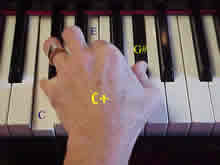 C+ = C-E-G# |
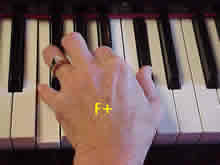 F+ = F-A-C# |
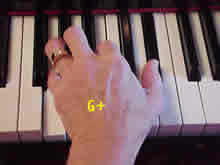 G+ = G-B-D# |
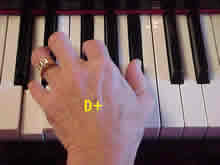 D+ = D-F#-A# |
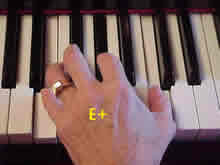 E+ = E-G#-C |
 A+ = A-C#-F |
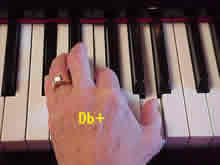 Db+ = Db-F-A |
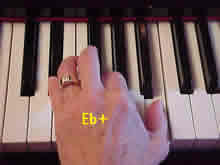 Eb+ = Eb-G-B |
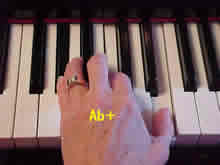 Ab+ = Ab-C-E |
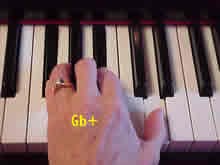 Gb+ = Gb-Bb-D |
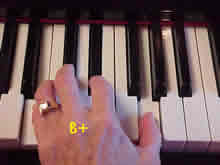 B+ = B-D#-G |
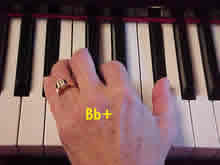 Bb+ = Bb-D-F# |
Now it's up to you. Play each augmented triad in root position, then 1st inversion, then 2nd inversion. Play each chord up and down the keyboard for at least 2 octaves -- maybe 3 octaves. Play them with your left hand, then play them with your right hand. Then play them hands together.
Go through all 12 major chords, inverting every one. Then go through all the 12 minor chords, inverting each one up and down the keyboard -- hands alone, then hands together. Then go through all 12 diminished chords, inverting each one up and down the keyboard -- each hand alone, then together. Then play the 12 augmented chords, up and down the keyboard. Then skip around from major to minor to diminished to augmented, etc.
When you can do that you ought to feel really, really, really optimistic about learning chords, because you've got a great start. After all, you have gone from:
12 major chords + 12 minor chords +
12 diminished chords + 12 augmented chords
and 3 inversions of each means you can now play
144 chords!
That's 12 dozen, a gross of chords! -- more than most people learn in their entire life -- and you've learned them in 7 weeks!
Yea! 'Way to go!
Now that we have covered all the triads (3 note chords), we'll take up 6th chords -- they are extensions of the basic major and minor chords.
![]()

